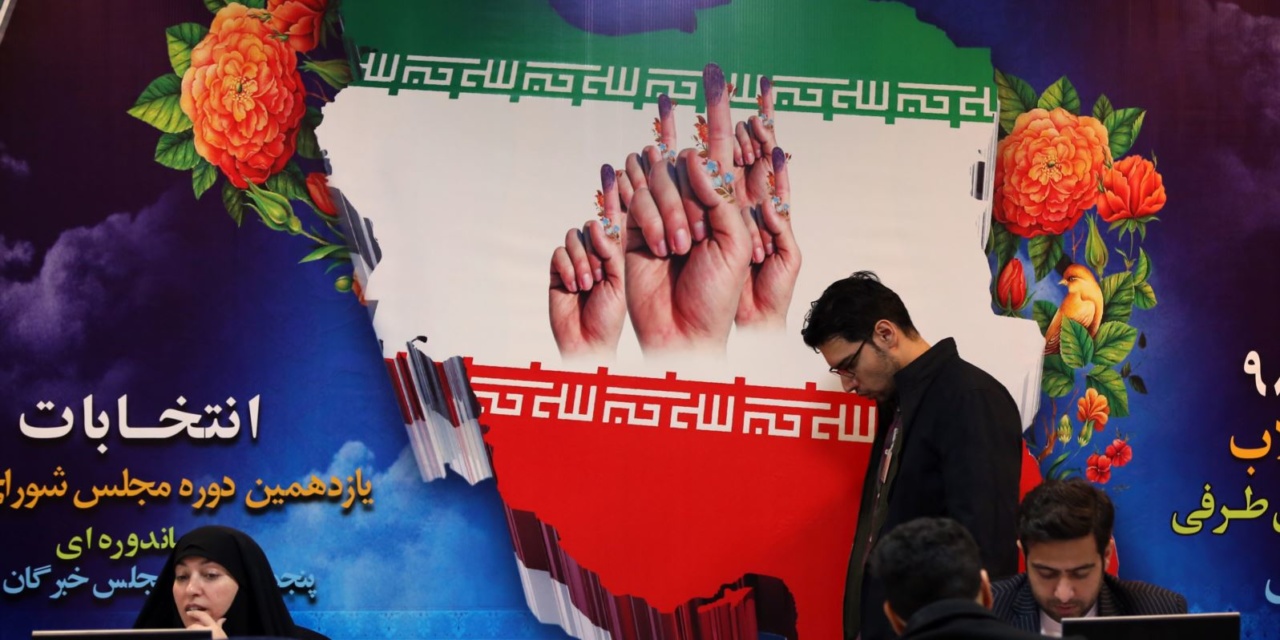A voter registration station in Tehran, December 2019 (Abedin Taherkenareh/EPA-EFE)
Less than a week before the February 21 Parliamentary elections, Iran’s officials are betraying concern about a low turnout amid the mass disqualification of reformist candidates.
Frud Bezhan of Radio Free Europe/Radio Liberty summarizes the tension, even as institutions like the Guardian Council are ensuring a reversal of the 2016 outcome when centrists and reformists took the largest share of seats in the Majlis.
The Council has blocked about half of the 16,000 candidates. It had barred even more, including 92 current MPs, but President Hassan Rouhani publicly chided, “They should at least let there be competition and high turnout.”
The Council, whose 12 members are named by the Supreme Leader and judiciary, then reinstated about 2,000 candidates.
Still, reformists say 90% of their applicants have been barred.
Rouhani appealed to a crowd on Tuesday, the 41st anniversary of the Islamic Revolution, “I beg you not to be passive.”
The Supreme Leader has appealed for a high turnout as a display to Iran’s “enemies”, insisting that it will solve all of Iran’s economic and social problems.
Rouhani’s spokesman Ali Rabiei said, as the Council disqualified candidates, “The upcoming elections are the most important elections in the history of the Islamic Republic. The only way to prevent the collapse of Iran is by going to the polls.”
Ayatollah Ahmad Alamolhoda, the Friday Prayers Leader in Iran’s second city Mashhad, tried another approach: “Those who do not take part in the elections will go to hell.”
But a February 5 poll by the state-run News Network indicated almost 80% of respondents will not participate in the elections. The initial survey was deleted, but later polls had similar results.
The polls were again removed, with a News Network presenter saying that the Telegram channel for the surveys was fake.
Bezhan quotes EA’s Scott Lucas:
Turnout is more important than who takes the majority of seats in Parliament.
Khamenei tipped off that priority when he appealed for a high turnout as a message to Iran’s enemies. The question is to what extent the regime will massage the turnout figures to get the magic number that it wants to declare victory over those enemies — both at home and abroad.


Scott,
1. WHO were these Interior Ministry officials whom Reuters spoke with? Unnamed sources just won’t do.
2. How is it that Reuters claim Iranian officials told them 1,500 killed, exactly a week after the MEK made the same claim??
3. Why would Iranian officials admit to this and be willing to share such information anyway??!!
You are just asking people to chuck their brains aside and believe a news agency not present within Iran.
Reza (Kushajan),
Again, your questions are best directed to the Interior Ministry officials who spoke to Reuters.
S.
I don’t know how to direct my questions to imaginary persons.
Scott,
Reuters likely never spoke to anyone within the Interior Ministry. It is a fake news report. But the MEK *did * first came up with the 1,500 figure.
I am not accusing Amnesty of lying.They could have been fed false or misleading information from their sources within Iran. I am asking why they are unable to produce a list of names, ages, locations and (if possible) photos when Bahari’s Iranwire has released such information (although nothing like 300 names).
Take this list produced by the Kurdish human rights group, Hengaw, on 6 deaths in the town of Marivan which witnessed fierce clashes:
https://hengaw.net/en/news/the-identity-of-six-protesters-killed-in-marivan-is-verified
I don’t know if the list is accurate (Amnesty used Hengaw as a source), but at least it is verifiable/falsifiable. I recall reading on Monday Nov 18th, that only 12 people had been confirmed killed according to the BBC and VOA: https://www.bbc.co.uk/news/world-middle-east-50459971
How this tally could have reached 1,500, or even 304, is beyond all credibility.
Reza (Kushajan),
As you have no evidence that Reuters lied, we’ll park your unsupported claim. And we’ll also park your unsupported speculation about Amnesty.
S.
You have no evidence that Reuters’ report is in any way accurate. How can I prove that unicorns do not exist?
Amnesty has just given a figure of 304 which you are telling us all to believe without any supporting evidence.
Reza (Kushajan),
You miss the point. Reuters is citing *three Iranian Interior Ministry officials”.
If you think those officials are unicorns, take it up with the Ministry.
I know of Amnesty’s methodology to verify the deaths — which is why I report it as absolutely reliable.
S.
In May of 2019, Iranpoll asked Iranians if they would vote in the 2020 Majlis elections: https://static1.squarespace.com/static/5525d831e4b09596848428f2/t/5da734202da90301ed6f707f/1571238944905/CISSM_IranPoll_All_trend_tables_FINAL.pdf
Back then, 57.3% said they were “very likely” to vote. This was before the recent protests/riots took place in which “dozens” were killed according to the UN: https://www.bbc.co.uk/news/world-middle-east-50474405
Reza (KUSHAJAN),
Verified information obtained by Amnesty International established that 304 demonstrators were killed by Iranian security forces in November. Activists claim the number is far higher.
Three officials in Iran’s Interior Ministry have said that the death toll — protesters, security forces, and bystanders — was 1,500.
S.
Correction: A fakenews Reuters report CLAIMING to have spoken to three Interior Ministry officials has announced that 1,500 were killed . The Interior Ministry has not issued any casualty count. It is widely acknowledged that Reuters was using information supplied to them by the MEK:
“Reuters Confirms NCRI’s Death Tally of 1500 From Crackdown on Iran Protests”: https://www.ncr-iran.org/en/news/iran-protests/27120-reuters-confirms-ncri-s-death-tally-of-1500-from-crackdown-on-iran-protests
Amnesty International has not produced a list of names, ages, locations and photos except for about 30 people to back up their claim of 304 killd. Iranwire claims 160 were killed, but also has not produced a list of names to that number: https://iranwire.com/en/features/6476
Reza (Kushajan),
So Reuters was duped by three men who *claimed* to be Interior Ministry officials? Interesting — look forward to any evidence you have for this. Citing MEK propaganda — since you dismiss the MEK as propagandists — as your source is ironic, to say the least.
And what evidence do you have that Amnesty is lying? Can you see any reason why Amnesty might *not* publish names — you know, since families have been threatened with retribution for speaking with “Western” outlets?
S.
A look at the 2 reformists lists for Tehran: https://www.khabaronline.ir/news/1352776
The Kargozaran (Executives) party and a coalition of 7 small reformist parties are sharing 20 candidates with 10 unique to each list.
The Neda (Voice) party has now declined to produce its own list as it said it previously claimed it would.
As such, there are 40 reformist candidates standing for the 30-seat Tehran constituency.
In 2016, reformists could only muster 15 reformists, 10 independents and 5 principlists on one list for Tehran.
Reza (KUSHAJAN),
Yes — as we noted from reformists, more than 90% of their candidates were blocked. Kargozaran is a centrist, not a reformist, party. So the reformists have been restricted to a handful of candidates.
Centrists and reformists won all 30 seats in Tehran in 2016.
S.
2,O00 reformists registered to vote this tie. So 10% of 2000 is 200, which is enough to win an outright majority. So more than a “handful”.
Karogozaran-e-Sazandegi is a founding member of the Reformist Front Coordination Council. Its list for Tehran includes reformist candidates.
The reformist (Hope) list for Tehran in 2016 included only 15 reformists on it and had to be supplemented with independents and principlists.
Reza (Kushajan),
“2,000 reformists registered to vote”? Surely you meant candidacies — but you need to verify that number and specify which reformist parties to which you are referring.
In any case, I appreciate your confirmation that 90% were disqualified by the Guardian Council.
And again you’re conflating centrists (pro-Rafsanjani Kargozaran) and reformists, so we can park whatever point you’re trying to make with that.
S.